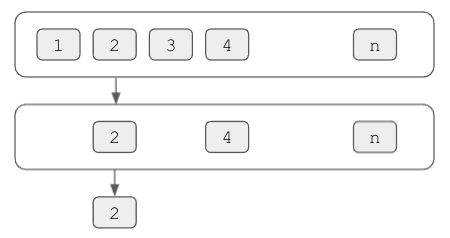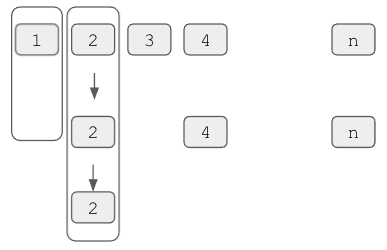Sequence: lazy evaluation
What is Sequence? A Kotlin Sequence is like a List, but you can only iterate. You cannot index into Sequence. And this restriction produces very efficient chained operations.
In other functional programming languages, Kotlin Sequence are called streams. Since Java 8 has Stream library, Kotlin has to choose another name to keep interoperability with Java.
List vs Sequence
The operation on Lists are performed eagerly - they always happen immediately. When chaining List operation, the first result must be done before starting the next.
list.listOf(1, 2, 3, 4)
.filter { it % 2 == 0 }
.any { it > 0 }

In this example, filter() operation from 1 to n must be completed before it can go to any() operation. Eager evaluation is intuitive and straightforward, but can be suboptimal. If you look carefully on the above example, it would make more sense to stop after encountering the first element that will satisfies the any(). This optimization might be much faster than evaluating every element and then search for a single match.
Eager evaluation is called horizontal evaluation.
The alternative to eager evaluation is lazy evaluation : a result is computed only when needed.

Performing lazy operations on sequence is called vertical evaluation.
With lazy evaluation, an operation is performed on an element only when that element’s associated result is requested. If the final result of a calculation is found before processing the last element, no further elements are processed.
This lazy evaluation optimization is simply done by converting List to Sequence using asSequence().
list.listOf(1, 2, 3, 4)
.asSequence()
.filter { it % 2 == 0 }
.any { it > 0 }
Two types of operation
There are two categories of Sequence operations: intermediate and terminal. Intermediate operations return another Sequence as a result. filter() and map() are intermediate operations.
Terminal operations return a non-Sequence. To do this, a terminal operation executes all stored computations. For example, any() is the terminal operation that returns Boolean.
Size of Sequence
Collections are a known size, discoverable through their size property. Sequences are treated as if they are infinite.
So what happen if we want to get some items - takeIf can be used, followed by a terminal operation like toList() or sum().
items.takeIf { it % 2 == 0 }.toList()
Summary
Sequences are a part of the language standard library and allow lazy evaluation of large amount of data (in millions), as opposed to collections, which compute and evaluate operations on a data set eagerly.
